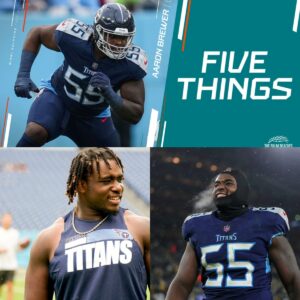
Chiefs’ Blake Bell Kisses Pregnant Wife Lyndsay and Daughter Brinleigh as They Celebrate 2024 Super Bowl Win
Blake Bell had his favorite fans on hand as he took on Super Bowl LVIII. The Kansas City Chiefs tight end, 32, was greeted by wife Lyndsay Bell —…

‘In Pat we trust’: Chiefs pay tribute to Super Bowl MVP Mahomes
Patrick Mahomes’s teammates were full of praise for their quarterback on Sunday night as he led them to a second successive Super Bowl title and their third championship in…

LAKERS NEWS: Austin Reaves: Rui Hachimura Barely Talked After First Joining Lakers But Now Has Built Close Friendship
Two of the biggest performers last postseason for the Los Angeles Lakers outside of LeBron James and Anthony Davis were Austin Reaves and Rui Hachimura. L.A. needed them to provide additional scoring help outside of the stars and they solidified their …

DRAFT BUZZ: Dolphins Eyeing Top Center Prospect Jackson Powers Johnson for Mike McDaniel’s Scheme
March 22, 2024 In the ever-evolving landscape of football, every draft season introduces a new beacon of hope for teams looking to bolster their ranks with fresh talent. This year, amid a class bustling with potential, Jackson Powers Johnson, more fondly …

TRADE RUMORS: Fans Buzz Over Possible Tagovailoa Move to Vikings
March 23, 2024 The Miami Dolphins, who have not yet offered quarterback Tua Tagovailoa a contract extension despite picking up his fifth-year option, are sparking trade rumors among football fans. Speculation is growing that the Dolphins may not view …

Embrace the Glitz and Glamour with Angelina Jolie in the Latest Issue of InStyle
InStyle Magazine Germany is kicking off the new year with a special feature showcasing the timeless beauty of Angelina Jolie. The January 2016 edition gives readers an inside peek into the world of this versatile actress, director, and activist, capturing …

The Riddick films show Vin Diesel’s rise to peak Diesel-ness
Vin Diesel has dominated several franchises. His most popular one is unarguably Fast & Furious, but the film series that best chronicles his career are the three Riddick movies, the first two of which are currently streaming on Peacock . Each one …

Lakers Injury Report: LA Given Huge Update on Crucial Role Player’s Status For Matchup vs 76ers
The Los Angeles Lakers have been dealing with all sorts of injuries this season, seeing multiple players be in and out of the lineup. It has hurt the team in the standings, but there is some hope for a few of their currently hurt players. According to …

HOT NEWS: Shaq Barrett- I Can Be The Top Edge Rusher In The NFL
Bucs sacks king Shaq Barrett, now playing for the Dolphins, continues to talk big after the Bucs kicked him out of One Buc Palace and his fat contract a few weeks ago. That’s sounds harsh, but it’s NFL reality. Shaq talked about it recently, and he went …

DEAL SEALED: Dolphins Secure Aaron Brewer with $21M Contract
March 22, 2024 In the ever-evolving dance of NFL roster management, the Miami Dolphins have made a strategic move to shore up their offensive line for the 2024 season and beyond. They’ve signed Aaron Brewer, a decision that’s both a statement of intent …